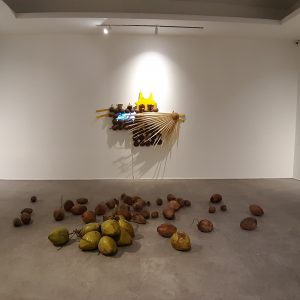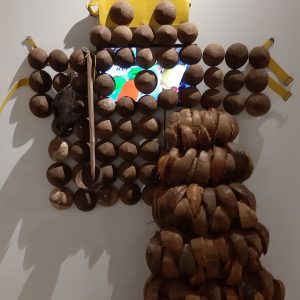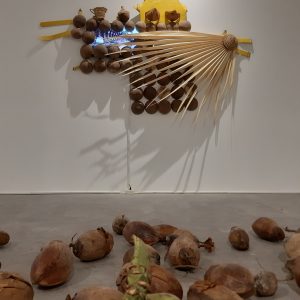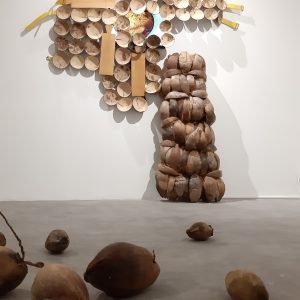My project is about how handwork or manual skills have become something of importance and a means for human reflection in this global era amid the pandemic. Craftspeople with specialised skills are currently struggling as export orders have diminished and the world of tourism has virtually come to a standstill. People are generally only shopping for basic necessities. In my visual works, I often work with highly skilled people working in leather, wood, and rattan, etc. I usually spend great lengths of time in their workshopsin a collaborative process where Idirectly input my ideas while they work.
Currently, this kind of process is not possible as it is potentially unsafe. Thus, we need to find new ways of working. My interest is inexamining the material culture of Indonesian society and by examining a specific material, I relate this to social, environmental and political issues. For this project, I explored the extensive use of the coconut. I believe that the coconut – the fruit, tree, and palms significantly contribute to the wellbeing and survival of Indonesians in daily life and in crises. I have chosen to leave issues related to the controversial kelapa sawit (oil palms) plantations out of this project.
Living in the tropics is intrinsically linked with the coconut tree, where it is a vital part of human life and survival. The entire coconut tree is utilised in providing basic human needs on both the physical and spiritual levels – and everything in between.
food and body treatments – nutrition, healing, tonics
physical protection-housing, clothing, packaging
spiritual– in offerings and rituals
Food for nutrition (coconut water/milk, coconut meat, coconut oil), and comfort (palm sugar, palm wine). Coconut also has medicinal uses and used in healing, for example, coconut water can be used as an infuse and coconut meat is given to children with worms. The boiled roots can be used for fever, skin diseases or diarrhoea. Other parts of the tree are used as house building materials for roofs (palm fiber), walls and construction (palms, wood) as well as for clothing, packaging and baskets. Coconut shells are used in table wear or are processed into charcoal for cooking among various other uses.
The fruit and different parts of the coconut tree are central to many traditional rituals in Indonesia, as important elements of offerings and temple decorations and various marriage, birth and death rituals. Multitudinous meanings (makna) are transferred through coconut water, shells, and palms into hope for prosperity and wellbeing for all those concerned.
When I was seven months pregnant with my first child, my family held a ritual (mitoni), whereby my mother-in-law inserted two young coconuts inside my sarong that rolled over my belly, while another family member caught the mas they fell out beneath my sarong, symbolising (and hoping for) a smooth delivery.
When I was involved in a project in Munduk, Bali, creating a cremation altar, I learnt that following a cremation, the ashes of the cremated person were put into a young coconut and thrown into the nearest river or sea. In the belief of a fluid reincarnation cycle, likewise, soon after the birth of a new born baby, the placenta is put into an old coconut and buried near its home.
I created three costumes/objects. ‘Kepala – Kelapa’ highlighting the correlation between basic necessities and all parts of the coconut that embody meaning.







